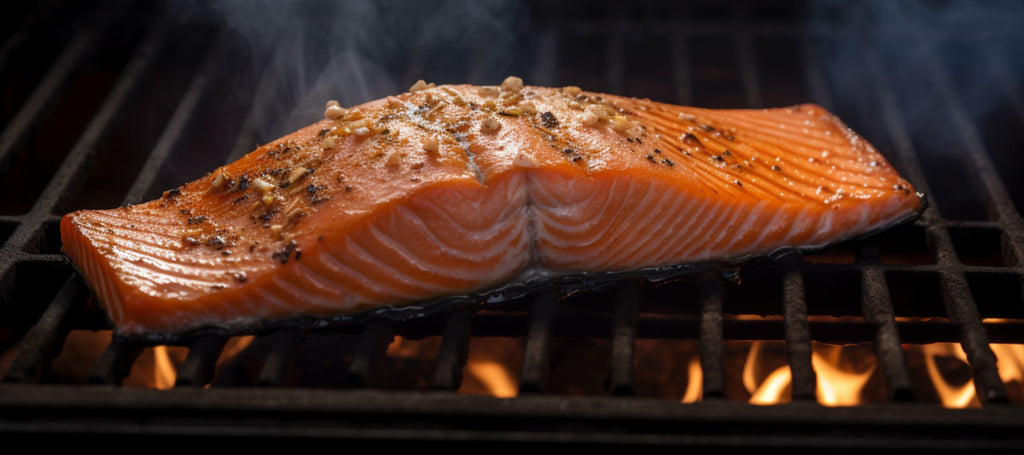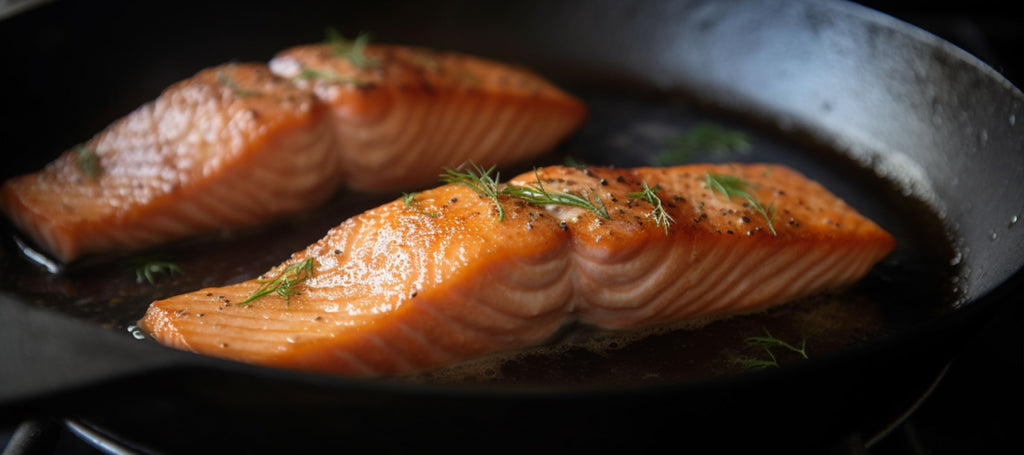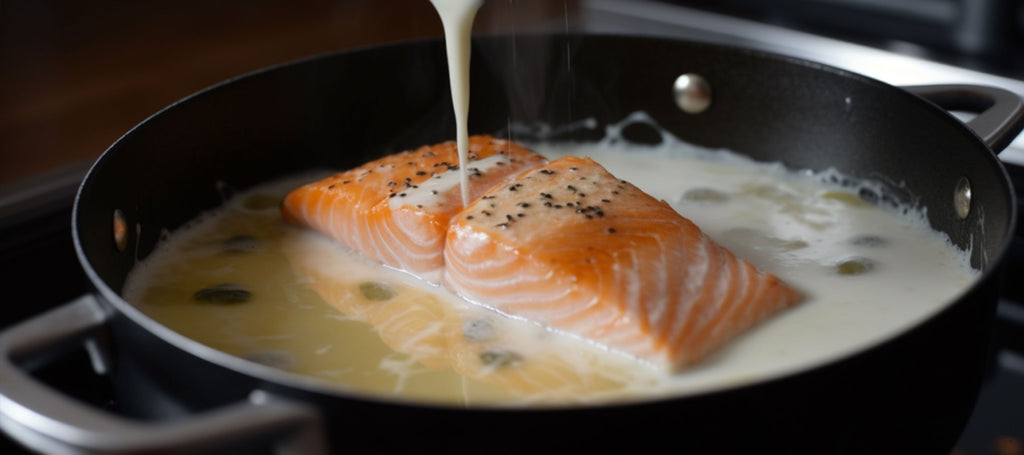
Salmon is a popular fish that is enjoyed by many for its delicious flavour and rich omega-3 fatty acid content. However, cooking salmon correctly is essential for both taste and food safety. Checking the internal temperature is one of the most crucial factors in ensuring that your salmon is perfectly cooked. This article will dive into the topic of salmon internal temperature, providing you with all the information you need to cook salmon to perfection every time.
Table of contents
What is the Ideal Salmon Internal Temperature?
The internal temperature of salmon is a crucial factor in determining its doneness and overall quality. The ideal internal temperature for cooked salmon is 145°F (63°C). This temperature ensures that the salmon is cooked and safe to eat while maintaining its moisture and flavor.
What Happens if the Salmon is Overcooked?
Overcooked salmon can be dry, tough, and flavorless. If the internal temperature of the salmon exceeds 145°F (63°C), it can become overcooked and lose its moist, tender texture. Additionally, if the internal temperature goes too high, it can become unsafe to eat, as harmful bacteria can grow at high temperatures.
What Happens if the Salmon is Undercooked?
Undercooked salmon can contain harmful bacteria and parasites that can cause foodborne illness. Additionally, undercooked salmon may have a raw, slimy texture that is unappetizing. To ensure that your salmon is Baked to the right temperature, it is essential to use a food thermometer to check the internal temperature of the fish.
How to Cook Salmon to the Perfect Internal Temperature
Baking
Cooking salmon to the perfect internal temperature is easy. Follow these steps to ensure that your salmon is cooked to perfection every time:
- Preheat your oven to 450°F (230°C).
- Place the salmon on a baking sheet lined with parchment paper.
- Brush the salmon with oil and season it with salt, pepper, and other seasonings.
- Bake the salmon for 10-12 minutes or until the internal temperature reaches 145°F (63°C).
- Remove the salmon from the oven and let it rest for a few minutes before serving.
Other Cooking Methods for Salmon
While baking is a popular and easy method for cooking salmon, other cooking methods can produce delicious results. Some of these methods include:
Grilling salmon

-
Start by preheating the grill to medium-high heat (about 375-400°F). Clean the grates with a wire brush and oil them lightly to prevent the salmon from sticking.
-
While the grill is heating up, prepare the salmon. Rinse the salmon fillets under cold water and pat them dry with paper towels. Brush both sides of the salmon with olive oil and season with salt and pepper. You can also add other seasonings, such as garlic powder, smoked paprika, or lemon zest, to your liking.
-
Once the grill is hot, place the salmon fillets on the grates, skin-side down. Close the lid and cook for about 6-8 minutes on each side, or until the internal temperature of the salmon reaches 145°F (63°C) when measured with a meat thermometer. Avoid flipping the salmon more than once, as this can cause it to fall apart.
-
If you want to add some extra flavor to the salmon, you can brush it with a glaze or sauce during the last few minutes of cooking. Some popular options include teriyaki sauce, honey mustard glaze, or a balsamic vinegar reduction.
-
Once the salmon is done, remove it from the grill using a spatula and transfer it to a platter or individual plates. Let it rest for a few minutes before serving, as this allows the juices to redistribute and the salmon to firm up slightly.
-
Garnish the salmon with fresh herbs, lemon wedges, or any other toppings you like. Enjoy your delicious grilled salmon with a side of vegetables, rice, or salad for a healthy and satisfying meal!
Pan fried

-
Start by preparing the salmon. Rinse the salmon fillets under cold water and pat them dry with paper towels. Season both sides of the salmon with salt and pepper, or any other seasonings of your choice.
-
Heat a tablespoon of oil in a non-stick pan over medium heat. Once the oil is hot, add the salmon fillets, skin-side up. Sear the salmon for 2-3 minutes until it develops a golden-brown crust on the bottom.
-
Carefully flip the salmon fillets over using a spatula, so that the skin-side is down. Continue cooking for another 2-3 minutes or until the salmon is cooked through and slightly opaque in the center.
-
If you want to add extra flavor to the salmon, you can add aromatics such as garlic or herbs like thyme, rosemary or dill to the pan along with the salmon. You can also finish the salmon with a squeeze of lemon juice or a drizzle of balsamic glaze.
-
Once the salmon is done, remove it from the pan using a spatula and transfer it to a platter or individual plates. Allow the salmon to rest for a few minutes to allow the flavors to meld.
-
Garnish the salmon with chopped herbs or a sprinkling of toasted nuts for added texture and flavor. Serve the salmon with your favorite sides, such as roasted vegetables or a side salad for a nutritious and satisfying meal.
poaching

- Start by preparing the poaching liquid. You can use water, stock, or wine, and add aromatics such as herbs, spices, or citrus to infuse flavor into the salmon. Bring the liquid to a gentle simmer over medium heat.
- While the liquid is heating up, prepare the salmon. Rinse the salmon fillets under cold water and pat them dry with paper towels. Season both sides of the salmon with salt and pepper, or any other seasonings of your choice.
- Once the poaching liquid is simmering, carefully add the salmon fillets to the saucepan. Make sure the salmon is fully submerged in the liquid.
- Reduce the heat to low and let the salmon poach for 5-7 minutes, or until the internal temperature of the salmon reaches 145°F (63°C) when measured with a meat thermometer. Avoid overcooking the salmon, as it can become dry and tough.
- Using a slotted spoon or spatula, carefully remove the poached salmon from the liquid and transfer it to a platter or individual plates. Allow the salmon to rest for a few minutes to allow the flavors to meld.
- Garnish the salmon with chopped herbs, such as dill or parsley, and a lemon wedge. You can also serve the salmon with a creamy sauce, such as hollandaise or beurre blanc, for added richness and flavor.
- Serve the poached salmon with your favorite sides, such as steamed vegetables, rice, or a side salad for a healthy and satisfying meal.
Safety Considerations for Cooking Salmon
In addition to cooking salmon to the correct internal temperature, there are a few other safety considerations to keep in mind when preparing this delicious fish. These include:
- Store salmon in the refrigerator at 40°F (4°C) or below to slow the growth of bacteria.
- Do not allow raw salmon to come into contact with ready-to-eat foods, as this can cause cross-contamination.
- Wash your hands, utensils, and cutting boards thoroughly before and after handling raw salmon.
FAQs
Q: What is the difference between wild salmon and farmed salmon?
A: Wild salmon are caught in their natural habitats, while farmed salmon are raised in contained environments. Wild salmon is considered a healthier option as they contain fewer contaminants and a higher omega-3 fatty acid content. On the other hand, farmed salmon are less expensive and readily available.
Q: Can you cook salmon from frozen?
A: Yes, you can cook salmon from frozen, but it may take longer to reach the ideal internal temperature. To cook frozen salmon, simply place it in a preheated oven and bake for 10-15 minutes or until the internal temperature reaches 145°F (63°C).
Q: What are some common seasonings to use when cooking salmon?
A: Some common seasonings to use when cooking salmon include salt, pepper, lemon juice, dill, garlic, and soy sauce. Feel free to experiment with different seasonings to find your preferred flavour combination.
Conclusion:
Cooking salmon to the perfect internal temperature is essential for taste and food safety. By following the steps outlined in this article, you can ensure that your salmon is cooked to perfection every time.
Whether you prefer to bake, grill, pan-fry, or poach your salmon, following these guidelines will help you achieve delicious results. Remember to use a food thermometer to check the internal temperature of the fish, and always keep safety considerations in mind when preparing and handling raw salmon.




